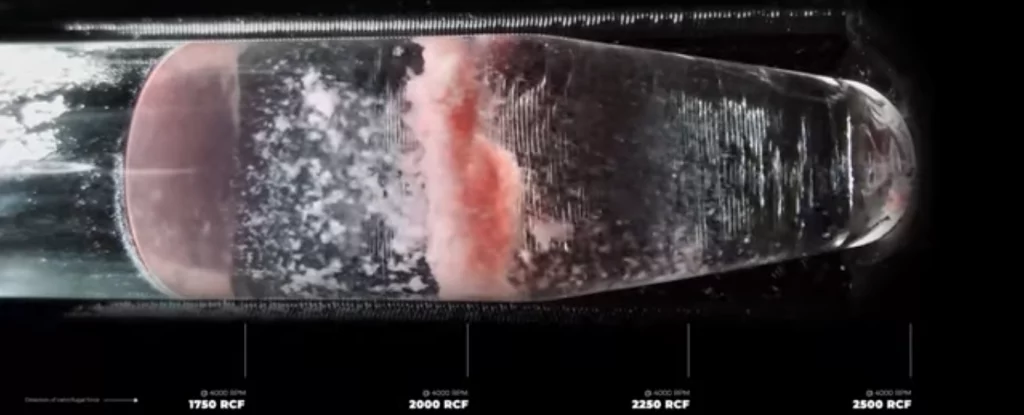
Transformed from a lab technician to a scientific photographer, an innovator has developed a camera enabling us to observe the inner workings of a centrifuge as it vigorously processes its samples.
The captivating videos not only hold our attention but, more significantly, unveil fluid dynamics with an unprecedented level of detail that we’ve never witnessed before.
Up until now, Dutch innovator Maurice Mikkers has directed his camera towards everyday fluids such as coffee, smoothies, and hot sauce. However, the applications of the centrifuge camera extend across diverse research fields, spanning physics and genetics, as well as food, wastewater treatment, and beyond.
While utilizing the centrifuge numerous times, Mikkers found that the internal workings of the machine remained a mysterious black box—a puzzle that the photographer within him always yearned to uncover.
During my time at the lab, my understanding was limited to visually observing the ‘pre-centrifuge’ and ‘post-centrifuge’ samples,” Mikkers expresses in an essay published on Medium.
Although he was familiar with the theoretical aspects of the process through scientific illustrations and animations, Mikkers clarified that “However, a live view of the separating process I have never seen included”.
In his quest to capture this phenomenon, Mikkers spent months experimenting, overcoming technical challenges inherent in attaching a digital camera to a rapidly spinning machine that generates forces 2,500 times stronger than Earth’s surface gravity. This not only impacts the sample being filmed but also poses challenges for the recording equipment itself.
Centrifuges operate by rapidly spinning fluids, generating powerful centrifugal forces. The outer layers of the centrifuge undergo more significant centrifugal force compared to the inner layers due to the larger circumference they cover in a single rotation.
Particle behavior within the fluid is influenced by this, with varying effects based on their density. Consequently, the components segregate into distinct layers, with the densest matter gravitating towards the outermost edge.
This technology is notably recognized for its application in isolating components of a blood sample—including red blood cells, white blood cells, platelets, and plasma—either for analytical purposes or blood donation.
Additionally, it finds application in isolating DNA from cells. Due to DNA’s lower density compared to other cellular components, it ascends to the top during centrifugation.
This seemingly straightforward technique plays a crucial role in virtually all genetic analysis and research. It ranges from mapping the genomes of various species to identifying viruses, parasites, and bacteria in the human body. Additionally, it facilitates the identification and manipulation of the codes that determine our physical traits.
Certain fluids captured by Mikkers’ camera do not undergo separation but reveal intriguing fluid dynamics that were previously unobservable using this method.
As an example, a comparison between the before-and-after shots provides no indication of the captivating swirls created when a shower gel is subjected to a 2500 g-force.
Centrifuges have found application in the realm of food science, capturing the attention of Alvaro Martin, a fluid physicist from the University of Twente in the Netherlands. He discussed Mikkers’ videos in a presentation on culinary fluid dynamics.
“The footage from the centrifuge camera is surprising for any fluid dynamicists due to the amount of motion present in most videos, far from a gentle separation motion and persistent for minutes,” Martin says.
Therefore, gaining insight into the inner workings of that small spin cycle holds significant importance for researchers across various fields, including genetics, physics, art, and even wastewater treatment.
Mikkers is currently in collaboration with rheologist Lorenzo Botto from the Delft University of Technology in the Netherlands on a project they’ve named ‘Sludgecam‘. This initiative explores the potential application of this technology in recovering valuable resources from wastewater sludge.
Upon extracting water from sewage, the remaining residue is a repugnant, malodorous, and perilous sludge. This substance is gaining recognition as a valuable source of nutrients, minerals, and synthetic materials like polymers, often referred to as a ‘gold mine.’
The project’s goal is to develop an intelligent centrifuge camera to assist operators of wastewater treatment plants in adjusting their sludge treatment processes based on its actual composition.
“It is the first time that researchers can see what happens inside a lab-scale centrifuge while it is spinning, and this will give many insights that can be applied not only to waste-water treatment but also to other applications such as biotechnology and food processing,” Botto says.
We eagerly anticipate witnessing more.





